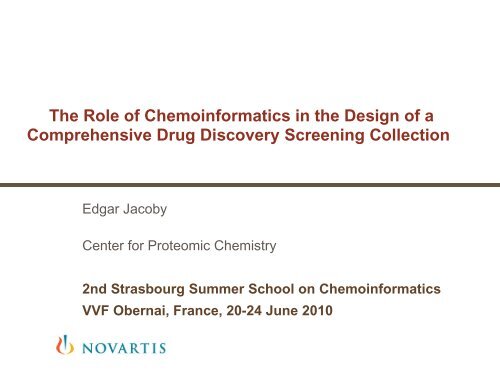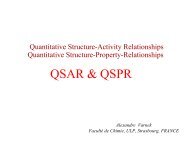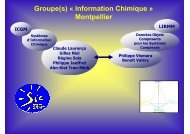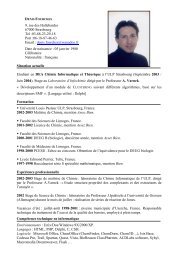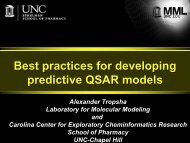The role of chemoinformatics in the design of a comprehensive drug ...
The role of chemoinformatics in the design of a comprehensive drug ...
The role of chemoinformatics in the design of a comprehensive drug ...
Create successful ePaper yourself
Turn your PDF publications into a flip-book with our unique Google optimized e-Paper software.
<strong>The</strong> Role <strong>of</strong> Chemo<strong>in</strong>formatics <strong>in</strong> <strong>the</strong> Design <strong>of</strong> a<br />
Comprehensive Drug Discovery Screen<strong>in</strong>g Collection<br />
Edgar Jacoby<br />
Center for Proteomic Chemistry<br />
2nd Strasbourg Summer School on Chemo<strong>in</strong>formatics<br />
VVF Obernai, France, 20-24 June 2010
Overview<br />
‣ NIBR compound collection enhancement project<br />
‣ External compound selection process<br />
‣ Comb<strong>in</strong>atorial library syn<strong>the</strong>sis – scaffold projects<br />
‣Compilation <strong>of</strong> annotated knowledge-based sets<br />
‣Molecular Information System for pharmaceutical ligands<br />
‣Knowledge-based ligand <strong>design</strong> and virtual screen<strong>in</strong>g strategies<br />
‣Chemo<strong>in</strong>formatics: Quo Vadis<br />
| Obernai| 20.06.10 | Edgar Jacoby
Essential Properties <strong>of</strong> Compounds<br />
| Obernai| 20.06.10 | Edgar Jacoby
Essential Properties <strong>of</strong> Compounds - Cont<strong>in</strong>ued<br />
| Obernai| 20.06.10 | Edgar Jacoby<br />
Jacoby et al. Chemogenomics 2007, 1-38
Externally Available Chemistry Space<br />
LDCStructuresDB<br />
‣Oracle and ISIS databases <strong>in</strong><br />
place<br />
‣10.000.000+ Unique structures<br />
‣13.000.000+ Catalogue entries<br />
‣130+ Collections<br />
‣50+ Vendors<br />
LDCScaffoldDB<br />
‣ Oracle and ISIS databases<br />
‣ 18.000+ Unique scaffolds<br />
‣ 15 Vendors<br />
| Obernai| 20.06.10 | Edgar Jacoby
Chemistry, Biology, Informatics Based Compound Selection<br />
0. <strong>The</strong> exist<strong>in</strong>g<br />
archive<br />
descriptor space<br />
Similar to Know MDDR<br />
Actives and Drugs<br />
1. Select from<br />
conta<strong>in</strong>er 1:<br />
(target family<br />
related aff<strong>in</strong>ity)<br />
high density,<br />
similarity
Substructure/Fragment Filters<br />
Def<strong>in</strong>ition <strong>of</strong> <strong>the</strong> Exclusion-Criteria:<br />
A: Don't store <strong>in</strong> MCS<br />
B: Don't produce as solution or store <strong>in</strong> SOLAR<br />
C: Don' buy (but take for free)<br />
ID Structure Chemical Description<br />
33 A<br />
Archive Exclusion Flag<br />
Toxic<br />
Un<strong>in</strong>terst<strong>in</strong>g Un<strong>in</strong>terest<strong>in</strong>g<br />
Reactive<br />
O carbonic acid nitriles Y Y N<br />
N<br />
34 A<br />
O O<br />
* O *<br />
*<br />
O O<br />
S<br />
O<br />
*<br />
*<br />
O O<br />
P<br />
O<br />
*<br />
acyclic acid anhydrides <strong>in</strong>clud<strong>in</strong>g<br />
phoshonates and phosph<strong>in</strong>ates, but<br />
not di- and triphospates<br />
Y Y N<br />
O O O O<br />
O O<br />
P<br />
O<br />
P<br />
S<br />
* S<br />
O P<br />
O S<br />
* * *<br />
*<br />
not:<br />
O<br />
O<br />
P<br />
O<br />
O<br />
P<br />
O<br />
O<br />
O<br />
35 B<br />
O O<br />
* O *<br />
O O<br />
S<br />
* O *<br />
O O<br />
P<br />
* O *<br />
cyclic acid anhydrides <strong>in</strong>clud<strong>in</strong>g<br />
phoshonates and phosph<strong>in</strong>ates, but<br />
not di- and triphospates<br />
Y Y N<br />
O O<br />
P<br />
O<br />
P<br />
*<br />
O O<br />
S<br />
O S<br />
* *<br />
O O<br />
S P<br />
* O *<br />
not:<br />
O<br />
O P O<br />
O<br />
O<br />
P O<br />
O<br />
36 C H O<br />
acyclic alkyl carbamates Y N N<br />
H<br />
O<br />
N<br />
| Obernai| 20.06.10 | Edgar Jacoby
In Silico Substructure Tox Alerts<br />
| Obernai| 20.06.10 | Edgar Jacoby
Chem<strong>in</strong>formatics Platform for Selection and Logistics<br />
Sample/catalogue entry doma<strong>in</strong><br />
Structure doma<strong>in</strong><br />
N<br />
Load Catalogue, add new structures (new), check<br />
availability for all compounds<br />
Y<br />
Export new structures for evaluation (exported)<br />
N<br />
Y<br />
Catalogue entry marked<br />
Catalogue entry<br />
as rejected<br />
marked as selected<br />
Y<br />
N<br />
Structure based<br />
evaluation <strong>of</strong><br />
compounds<br />
Drug-Likeness and<br />
Target Focus<br />
Diversity<br />
Compound is not<br />
available<br />
N<br />
Don’t order (cancelled)<br />
N<br />
Confirm availability and<br />
price<br />
Y<br />
Decide to order<br />
Y<br />
Order placed (ordered)<br />
Structures processed<br />
<strong>in</strong> parallel acquisition<br />
processes<br />
not registered<br />
<strong>in</strong> corporate structure DB<br />
Diversity<br />
N<br />
Identity by structure (smiles)<br />
Compound received<br />
Y<br />
Register compounds<br />
(registered)<br />
registered<br />
<strong>in</strong> corporate structure DB<br />
Structures <strong>of</strong> “archive<br />
compounds”<br />
Schuffenhauer, A. et al. Comb. Chem. High Throughput Screen. (2004), 7, 771-782.<br />
| Obernai| 20.06.10 | Edgar Jacoby
Scaffold Tree Example for HTS Results<br />
PubChem Pyruvate K<strong>in</strong>ase Data Set<br />
Schuffenhauer et al. J Chem Inf Model. 2007, 47, 47-58.<br />
Color <strong>in</strong>tensity by<br />
fraction <strong>of</strong> actives<br />
| Obernai| 20.06.10 | Edgar Jacoby
Evaluation Scheme for Comb<strong>in</strong>atorial Hit Discovery Libraries<br />
2004<br />
Patentability<br />
Novelty <strong>of</strong> Scaffold<br />
Novelty <strong>of</strong> Products<br />
Modularity<br />
Preprototype Criteria<br />
Planned Size<br />
Ratio <strong>of</strong> Lowest and<br />
Highest Nr. <strong>of</strong> BBs<br />
Complementarity<br />
Library Evaluation<br />
Rule <strong>of</strong> Five<br />
InSilico Tox<br />
BB Availability<br />
BB Diversity<br />
Chiral Purity<br />
HT Solubility<br />
HT logP<br />
HT Permeability<br />
Prototype Criteria<br />
1 1 1 0 0 -1 1 1 1 1 1 1 0 0 0 0 0 -1 0 1 1<br />
CYP 450 (Metabolism<br />
HT HERG channal<br />
assay<br />
Ames test<br />
Ease <strong>of</strong> Realisation<br />
Time <strong>of</strong> Development<br />
Chemical Stability<br />
1<br />
0<br />
-1<br />
2007<br />
novelty<br />
target<br />
focus<br />
syn<strong>the</strong>tic<br />
complexity<br />
potential<br />
for HLO<br />
computed<br />
properties<br />
Jacoby et al. Curr Top Med Chem. 2005, 5, 397-411<br />
| Obernai| 20.06.10 | Edgar Jacoby
<strong>The</strong> Ideal Size <strong>of</strong> Comb<strong>in</strong>atorial Libraries<br />
| Obernai| 20.06.10 | Edgar Jacoby
Monitor<strong>in</strong>g <strong>of</strong> Compound Collections - Lip<strong>in</strong>ski Pr<strong>of</strong>iles<br />
12.0%<br />
AlogP Distribution<br />
40.0%<br />
H-Bond Donors<br />
35.0%<br />
10.0%<br />
30.0%<br />
% <strong>of</strong> samples<br />
8.0%<br />
6.0%<br />
4.0%<br />
CHC [%]<br />
SOLAR [%]<br />
CMedC [%]<br />
% <strong>of</strong> samples<br />
25.0%<br />
20.0%<br />
15.0%<br />
CHC [%]<br />
SOLAR [%]<br />
CMedC [%]<br />
10.0%<br />
2.0%<br />
5.0%<br />
0.0%<br />
-5 -4 -3 -2 -1 0 1 2 3 4 5 6 7 8 9 10<br />
AlogP<br />
0.0%<br />
0 1 2 3 4 5 6 7 8 9 10<br />
Count<br />
10.0%<br />
Molecular Weight Distribution<br />
25.0%<br />
H-Bond Acceptors<br />
9.0%<br />
8.0%<br />
20.0%<br />
% <strong>of</strong> samples<br />
7.0%<br />
6.0%<br />
5.0%<br />
4.0%<br />
CHC [%]<br />
SOLAR [%]<br />
CMedC [%]<br />
% <strong>of</strong> samples<br />
15.0%<br />
10.0%<br />
CHC [%]<br />
SOLAR [%]<br />
CMedC [%]<br />
3.0%<br />
2.0%<br />
1.0%<br />
5.0%<br />
0.0%<br />
0 100 200 300 400 500 600 700 800 900 1000<br />
Molecular Weight<br />
| Obernai| 20.06.10 | Edgar Jacoby<br />
0.0%<br />
0 1 2 3 4 5 6 7 8 9 10 11 12 13 14 15<br />
Count
Prediction <strong>of</strong> Water Solubility<br />
10.0<br />
-logS n (exp, equilibrium)<br />
9.0<br />
8.0<br />
7.0<br />
6.0<br />
5.0<br />
4.0<br />
3.0<br />
2.0<br />
logS vs AlogP, no salt<br />
logS vs AlogP, salt<br />
1.0<br />
GSE Limit -logS >= logP + 0.5<br />
Limit -logS >= logP<br />
0.0<br />
0 2 4 6 8 10<br />
AlogP<br />
-logS pH6.8(exp,equilibrium)<br />
10.0<br />
9.0<br />
8.0<br />
7.0<br />
6.0<br />
5.0<br />
4.0<br />
3.0<br />
2.0<br />
1.0<br />
<strong>in</strong>side model range<br />
outside model range<br />
salts<br />
exact<br />
-1 log unit<br />
+1 log unit<br />
0.0<br />
0.0 1.0 2.0 3.0 4.0 5.0 6.0 7.0 8.0 9.0 10.0<br />
-logS pH6.8(QMPRPlus, Cor<strong>in</strong>a 3D structure)<br />
10<br />
10<br />
-logS n (exp, equilibrium)<br />
9<br />
8<br />
7<br />
6<br />
5<br />
4<br />
3<br />
2<br />
1<br />
-logS pH6.8(exp, equilibrium)<br />
9<br />
8<br />
7<br />
6<br />
5<br />
4<br />
3<br />
2<br />
1<br />
151<br />
144<br />
147<br />
84<br />
148<br />
85<br />
149<br />
118<br />
146<br />
150<br />
153<br />
154<br />
152<br />
143<br />
145<br />
142<br />
142<br />
139<br />
112<br />
90<br />
140<br />
141<br />
137<br />
138<br />
76<br />
108<br />
109<br />
135<br />
134<br />
133<br />
136<br />
126<br />
127<br />
130<br />
129<br />
131<br />
128<br />
2<br />
132<br />
4<br />
1<br />
non_salt<br />
salt<br />
exact<br />
+1 log unit<br />
-1 log unit<br />
0<br />
0 1 2 3 4 5 6 7 8 9 10<br />
-logS n (QikProp, Cor<strong>in</strong>a 3D structures)<br />
0<br />
0 1 2 3 4 5 6 7 8 9 10<br />
-logS pH6.8(calculated,ACD)<br />
| Obernai| 20.06.10 | Edgar Jacoby
<strong>The</strong> “Egan Egg”: Statistical Prospectively Useful Model<br />
8<br />
Poor Solubility<br />
Access Egan Egg via IsisDraw<br />
InSilico Pr<strong>of</strong>ile T2ABS plot<br />
ClogP<br />
6<br />
4<br />
2<br />
0<br />
-2<br />
Higher<br />
Permeability<br />
• Good Hunt<strong>in</strong>g Grounds<br />
Higher<br />
Solubility<br />
Poor Permeability<br />
& Poor Solubility<br />
• Few marketed <strong>drug</strong>s lie<br />
<strong>in</strong> this region<br />
Poor Permeability<br />
• Drugs <strong>in</strong> this<br />
region usually<br />
work via pro<strong>drug</strong>s<br />
<strong>of</strong> active transport<br />
-20 0 20 40 60 80 100 120 140 160 180 200<br />
| Obernai| 20.06.10 | Edgar Jacoby<br />
PSA WJ Egan et al, JMC, 2000
Chemist Triage Score and Naïve Bayesian Models<br />
‣ Yes/No decision from five <strong>in</strong>dividual triag<strong>in</strong>g exercises taken to build one<br />
Bayesian models<br />
‣ All five models are used <strong>in</strong> a consensus score, fraction <strong>of</strong> models vot<strong>in</strong>g<br />
aga<strong>in</strong>st <strong>the</strong> molecules<br />
Chemist Triage Score<br />
100%<br />
90%<br />
16%<br />
Histogram <strong>of</strong> NB Score<br />
Screen<strong>in</strong>g Collection<br />
Less attractive cpds.<br />
Fraction <strong>of</strong> compounds<br />
80%<br />
70%<br />
60%<br />
50%<br />
40%<br />
30%<br />
20%<br />
10%<br />
0%<br />
MCS SLIA ICLF PSEB MCS<br />
external<br />
2003<br />
MCS<br />
external<br />
2004<br />
Drugs NAPR HTS Hits<br />
2004<br />
Random<br />
Chemist<br />
Triage<br />
Score<br />
Serie<br />
1<br />
s6<br />
Serie<br />
0.8<br />
s5<br />
Serie<br />
0.6<br />
s4<br />
Serie<br />
0.4<br />
s3<br />
Serie<br />
0.2<br />
s2<br />
Serie<br />
0<br />
s1<br />
% <strong>of</strong> samples<br />
14% Primary Hit-list<br />
12%<br />
Tra<strong>in</strong><strong>in</strong>g Set<br />
10%<br />
8%<br />
6%<br />
4%<br />
2%<br />
0%<br />
-100 -80 -60 -40 -20 0 20 40 60 80 100<br />
| Obernai| 20.06.10 | Edgar Jacoby
Examples <strong>of</strong> Unwanted Molecules<br />
ChemistTriageScore: Excluded<br />
N<br />
H<br />
O<br />
1.0<br />
N<br />
H<br />
O<br />
NH 2<br />
O<br />
N H<br />
N<br />
O<br />
H<br />
N<br />
Br<br />
N +<br />
Similog density: Excluded<br />
HO<br />
HO<br />
N<br />
H<br />
0.0012<br />
N<br />
H<br />
OH<br />
OH<br />
N + O OH<br />
Cl<br />
Cl<br />
H<br />
N<br />
Cl<br />
Cl<br />
O<br />
N +<br />
O<br />
O<br />
N<br />
F<br />
F<br />
F<br />
O<br />
HN<br />
O<br />
OH<br />
0.8 0.8<br />
0.0017<br />
ChemistTriageScore: Penalized<br />
Similog density: Penalized<br />
O<br />
O<br />
N<br />
HO<br />
S<br />
HO<br />
HO<br />
0.4<br />
Cl<br />
N<br />
NH<br />
Cl<br />
N<br />
O<br />
HO<br />
S<br />
O<br />
OH<br />
HO<br />
0.6<br />
F<br />
F<br />
F<br />
0.6<br />
F<br />
0.0029<br />
O<br />
O N<br />
0.0036<br />
N<br />
| Obernai| 20.06.10 | Edgar Jacoby
<strong>The</strong> Challenge <strong>of</strong> Quality <strong>in</strong> Candidate Optimization<br />
Biller S. et al. Biotechnology: Pharmaceutical Aspects, 2004, 413-429.<br />
| Obernai| 20.06.10 | Edgar Jacoby
Safety Pharmacology Prediction<br />
| Obernai| 20.06.10 | Edgar Jacoby
Which Annotated Compound Libraries Make Sense <br />
1. Approved <strong>drug</strong>s – FDA orange book - SOSA<br />
2. O<strong>the</strong>r reference compounds (USAN, INN) with known bioactivity (Tocris,<br />
Prestwick, etc.)<br />
3. Compounds processed by pr<strong>of</strong>il<strong>in</strong>g<br />
4. Primary metabolites, natural products and derivatives (KEGG, etc.)<br />
5. Target family focused libraries<br />
6. Diversity selection – DOS / BIOS<br />
7. Prote<strong>in</strong> mimetics library: β-turn/α-helix mimetics<br />
8. Fragment library for NMR/Xray screen<strong>in</strong>g<br />
| Obernai| 20.06.10 | Edgar Jacoby
Focus<strong>in</strong>g : Optimiz<strong>in</strong>g <strong>the</strong> Overlap Between Chemical and<br />
Biological Spaces<br />
Wess DDT 2002, 7, 533-535<br />
| Obernai| 20.06.10 | Edgar Jacoby
Knowledge-Based Virtual Screen<strong>in</strong>g<br />
Ligand-based<br />
T<br />
A<br />
R<br />
G<br />
E<br />
T<br />
Yes<br />
Annotation No<br />
Yes<br />
Known<br />
Actives <br />
No<br />
No<br />
Known<br />
Structure <br />
Yes<br />
Yes<br />
Are<br />
Actives<br />
‘Drug like’ <br />
No<br />
No<br />
Is b<strong>in</strong>d<strong>in</strong>g<br />
site ‘Drug<br />
like’ <br />
Yes<br />
Yes<br />
Select<br />
compounds<br />
similar to<br />
known actives<br />
Select<br />
compounds<br />
compatible to<br />
b<strong>in</strong>d<strong>in</strong>g site<br />
Similarity<br />
based list<br />
Diversity<br />
screen<strong>in</strong>g<br />
Structure<br />
based list<br />
Structure-based<br />
| Obernai| 20.06.10 | Edgar Jacoby
Molecular Information System for Pharmaceutical Ligands <strong>of</strong><br />
<strong>the</strong> Ma<strong>in</strong> Target Families<br />
Target<br />
MIS<br />
Reference<br />
Ligands<br />
Compound<br />
Selections<br />
Ligand -Target Sequence<br />
Ligand -Target Classification<br />
Ligand - Interaction Classification<br />
Ligand - Functionality<br />
Ligands<br />
Novartis<br />
MDDR,...<br />
Targets<br />
Swiss-Prot<br />
GPCRDB,...<br />
Schuffenhauer, A. and Jacoby, E. BioSilico ( 2004), 2, 190-200<br />
| Obernai| 20.06.10 | Edgar Jacoby
Databases <strong>of</strong> Known Pharmaceutical Ligands and Drugs<br />
Structure<br />
MDDR-3D 2001.1<br />
(23.01)<br />
Extreg 185987<br />
Pref#<br />
Preview<br />
Phase<br />
185987<br />
Act.<strong>in</strong>vest<br />
Launched<br />
Index Activity<br />
28000 Cardiotonic<br />
31000 Antihypertensive<br />
31432 Angiotens<strong>in</strong> II<br />
AT1 Antagonist<br />
Model<br />
Structure<br />
O<br />
Identification<br />
O<br />
N<br />
O<br />
Biology<br />
N<br />
N<br />
Lit & Patent<br />
Chiral<br />
N<br />
N<br />
Source<br />
Novartis<br />
Company.code<br />
CGP-48933<br />
CGP-63170 (comb. with<br />
Generic name<br />
Valsartan < Rec INN; USAN ><br />
Trademark<br />
Valpression (Menar<strong>in</strong>i, IT)<br />
Provas (Schwarz, DE)<br />
Varexan (Egis, HU)<br />
Di (N ti CA DE<br />
| Obernai| 20.06.10 | Edgar Jacoby
Knowledge Based Approaches : GPCR I<br />
MDL Patent Database<br />
Activity Based Search<br />
38 Patent Families<br />
1810 Reference Structures<br />
Similarity Search<br />
Naïve Bayes Model<br />
542 SOLAR <strong>in</strong> silico hits<br />
| Obernai| 20.06.10 | Edgar Jacoby
Similarity Search<strong>in</strong>g us<strong>in</strong>g Similog Keys<br />
P. Floersheim’s Similog keys<br />
counts <strong>of</strong> DABE triplets <strong>in</strong> 2D space<br />
6<br />
0100<br />
O<br />
0010<br />
O<br />
4<br />
O<br />
1100<br />
H<br />
6<br />
0010-4-1100-6-0100-6-<br />
1NN 3NN avg cent<br />
Schuffenhauer, A. et al. J. Chem. Inf. Comp. Sci. ( 2003), 2, 391-405.<br />
| Obernai| 20.06.10 | Edgar Jacoby
Design <strong>of</strong> TAM Libraries for Monoam<strong>in</strong>e-Related GPCRs<br />
Known Reference Architectures<br />
Novel Prototypes<br />
N H 2<br />
HO<br />
NH<br />
Seroton<strong>in</strong><br />
5HT ago.<br />
HO<br />
H<br />
N<br />
O<br />
Propranolol<br />
β antago.<br />
HO<br />
N<br />
8-OH-DPAT<br />
5HT1A part. ago.<br />
N<br />
Cl<br />
NH<br />
O<br />
N<br />
N<br />
H<br />
N<br />
N<br />
NH<br />
O S O<br />
Cl<br />
O<br />
O<br />
N<br />
N<br />
NH<br />
O<br />
F<br />
Ketanser<strong>in</strong><br />
5HT2A antago.<br />
HN<br />
Cl<br />
N<br />
N<br />
S<br />
N<br />
Cl<br />
Janssen_1<br />
D4 antago.<br />
N<br />
N<br />
O<br />
N<br />
O<br />
N<br />
WAY-100635<br />
5HT1A antago.<br />
HN<br />
O<br />
N<br />
N<br />
NH<br />
O S O<br />
Cl<br />
N<br />
N<br />
N<br />
N<br />
Cl<br />
NH<br />
N<br />
N<br />
O<br />
5HT7 antago.<br />
pKB = 7.25<br />
O<br />
O<br />
NH 2<br />
O<br />
N<br />
Cl<br />
HO<br />
H<br />
OH<br />
N<br />
OH<br />
N<br />
N<br />
RO-16814<br />
β ago.<br />
N<br />
H<br />
Kissei_1<br />
D2 antago.<br />
NH<br />
O S O<br />
Cl<br />
O<br />
O<br />
Jacoby, E. Quant. Struct. Activity. Relations. (2001) 20, 115-123.<br />
| Obernai| 20.06.10 | Edgar Jacoby
Deconvolute and recomb<strong>in</strong>e : Drug like molecules<br />
Currently applied knowledge-based strategy<br />
New Leads + New Aff<strong>in</strong>ity Pr<strong>of</strong>iles<br />
Recompose<br />
Databases <strong>of</strong> Active Fragments<br />
Deconvolute<br />
NOVARTIS DB<br />
CAS DB<br />
Jacoby et al. Drug News Perspect. (2003),16, 93-102.<br />
| Obernai| 20.06.10 | Edgar Jacoby
Ligand selectivity <strong>in</strong> a subfamily with conserved molecular<br />
recognition<br />
pKi<br />
α2A α2B α2C β1 β2 D2.L D3 D4.2 5HT1A 5HT1D 5HT1E 5HT1F 5HT2A H1<br />
Sumatriptan < 6 < 6 < 6 < 6 < 6 < 6 < 6 < 6 6.4 8.4 < 6 7.8 < 6<br />
Alniditan 7.4 6.8 7.7 < 6 < 6 < 6 6.5 7.1 8.4 9.4 6.6 6.4 < 6 < 6<br />
Haloperidol < 6 6 .3 6.2 < 6 < 6 8.7 8.1 7.9 < 6 6.6 < 6 < 6 6.7 6.1<br />
Pipamperone 6.1 7.5 6.5 < 6 < 6 6.9 6.6 8.3 < 6 6.8 < 6 < 6 8.3 < 6<br />
Clozap<strong>in</strong>e 7.3 7.7 8.1 < 6 < 6 6.7 6.6 7.4 6.9 6.4 6.4 6.9 8.0 9.6<br />
Olanzap<strong>in</strong>e 6.3 6.7 6.7 < 6 < 6 7.5 7.3 7.6 < 6 6.2 < 6 6.5 8.6 9.2<br />
Do we understand and master <strong>the</strong> pr<strong>in</strong>ciples <strong>of</strong> pr<strong>of</strong>ile composition <strong>in</strong><br />
terms <strong>of</strong> molecular recognition <br />
| Obernai| 20.06.10 | Edgar Jacoby
Focus <strong>of</strong> TAM library – Similarity Histograms<br />
6<br />
5<br />
Monoam<strong>in</strong>e GPCRs<br />
R1 R1'<br />
N<br />
R2<br />
4<br />
3<br />
2<br />
1<br />
0<br />
0<br />
0.1<br />
0.2<br />
0.3<br />
0.4<br />
0.5<br />
0.6<br />
0.7<br />
0.8<br />
0.9<br />
1<br />
% Compounds<br />
Peptide-b<strong>in</strong>d<strong>in</strong>g GPCRs<br />
LGIC<br />
Maximum Tanimoto Index<br />
| Obernai| 20.06.10 | Edgar Jacoby
A general strategy for creat<strong>in</strong>g “<strong>in</strong>active” conformation k<strong>in</strong>ase<br />
<strong>in</strong>hibitors - ABL<br />
Okram et al. Chemistry & Biology 2006, 13, 779–786<br />
| Obernai| 20.06.10 | Edgar Jacoby
Selectivity Analysis <strong>of</strong> Comb<strong>in</strong>atorial Libraries<br />
100%<br />
80%<br />
60%<br />
40%<br />
20%<br />
0%<br />
BCG-001<br />
BET-001<br />
BET-02A<br />
DIA-002<br />
IMO-001<br />
AAL-001<br />
BET-02B<br />
HOP-002<br />
HOP-003<br />
DIA-001<br />
PUR-003<br />
SYK-001<br />
AAL-002<br />
BZI-001<br />
GUA-003<br />
IMI-251<br />
OXI-001<br />
SRC-001<br />
TAM-003<br />
IAB-451<br />
IPO-825<br />
PUR-001<br />
TAM-001<br />
TAM-002<br />
TSA-003<br />
TAM-004<br />
TAM-005<br />
TSA-001<br />
Is Target Family Focus a Myth <br />
GPCR<br />
K<strong>in</strong>ase<br />
Protease<br />
o<strong>the</strong>r Enzymes<br />
NUR<br />
ion channel<br />
PPI<br />
functional<br />
| Obernai| 20.06.10 | Edgar Jacoby
Extend Knowledge-based Approaches<br />
• Target family based approaches<br />
• BIOS – Prote<strong>in</strong> doma<strong>in</strong> based <strong>design</strong>s<br />
• Privileged Scaffolds<br />
• Prote<strong>in</strong> Secondary Structure Mimetics: α-helix/β-turn<br />
• Co-factor mimetics: ATP, NADP, FAD, Co-A, SAM, etc.<br />
| Obernai| 20.06.10 | Edgar Jacoby
Privileged structures / Scaffold target matrix<br />
O<br />
O<br />
O<br />
N<br />
N<br />
N<br />
N<br />
N<br />
N<br />
O<br />
Naftopidil<br />
α 1<br />
antagonist<br />
HO<br />
O<br />
O<br />
O<br />
H<br />
N<br />
O<br />
N NH H N<br />
N<br />
N<br />
O<br />
N<br />
N<br />
N<br />
H<br />
N<br />
Cl<br />
N<br />
N NH<br />
Diovan<br />
Meiji Seko<br />
AT 1<br />
antagonist µ 1<br />
agonist / D 2<br />
antagonist<br />
H<br />
O N<br />
O<br />
H<br />
O<br />
O<br />
H<br />
N<br />
N<br />
NH 2<br />
N<br />
O<br />
O O<br />
N<br />
N<br />
H<br />
N<br />
N<br />
N<br />
N<br />
O<br />
Merck_1<br />
NK 1<br />
antagonist<br />
N<br />
H<br />
OH<br />
5HT1A<br />
5HT1B<br />
5HT1D<br />
5HT1F<br />
5HT2A<br />
5HT2B<br />
5HT2C<br />
5HT4<br />
A1A<br />
PS1 0 0 0 0 2 0 0 0 0 4 0 0 1 11 0 0 0 0 0 4<br />
PS2 0 0 0 0 0 1 1 0 0 0 0 0 0 2 0 14 0 0 0 4<br />
PS3 6 0 0 0 3 3 3 0 0 0 0 0 0 0 0 0 0 0 0 4<br />
PS4 2 0 0 0 1 1 1 0 0 0 0 0 0 0 0 0 0 0 0 4<br />
PS5 2 0 0 0 0 0 0 0 1 0 0 0 0 2 1 0 0 0 0 4<br />
PS6 0 0 0 0 0 0 0 0 1 1 1 0 0 0 0 3 0 0 0 4<br />
PS7 2 0 0 0 0 0 0 0 0 0 0 0 1 1 0 1 0 0 0 4<br />
N<br />
H<br />
NH<br />
N<br />
N<br />
A2A<br />
B1<br />
B3<br />
D1<br />
D2<br />
PS1 PS2 PS3<br />
PS4<br />
N<br />
N<br />
D3<br />
N<br />
N<br />
D4<br />
M1<br />
M3<br />
H2<br />
Frequency<br />
Servier_1<br />
NK 1<br />
antagonist<br />
Merck_2<br />
GHr agonist<br />
RS504393<br />
α 1A<br />
/ CCR 2b<br />
antagonist<br />
Pfizer_1<br />
CCK antagonist<br />
N<br />
NH<br />
O<br />
O<br />
O<br />
HN<br />
O<br />
N<br />
H<br />
N<br />
PS5 PS6 PS7<br />
| Obernai| 20.06.10 | Edgar Jacoby
Privileged structures GPCRs<br />
<strong>The</strong> 2-aryl-<strong>in</strong>dole case<br />
| Obernai| 20.06.10 | Edgar Jacoby
Co-factors<br />
Bioactive Motifs with Conserved B<strong>in</strong>d<strong>in</strong>g Sites <strong>in</strong> Enzymes<br />
| Obernai| 20.06.10 | Edgar Jacoby
Ligands vs. doma<strong>in</strong>s and folds that b<strong>in</strong>d <strong>the</strong>m<br />
Analysis <strong>of</strong> PDB – C<strong>of</strong>actor B<strong>in</strong>d<strong>in</strong>g Sites Open Large Potential Target Space<br />
Ligands Full name <strong>of</strong> ligands Number <strong>of</strong><br />
doma<strong>in</strong>s<br />
Number <strong>of</strong><br />
folds<br />
PLP Pyridoxal-5'-phosphate 17 10<br />
TDP Thiam<strong>in</strong>Diphosphate 36 10<br />
SAM S-adenosylmethion<strong>in</strong>e 41 13<br />
COA CoenzymeA 29 14<br />
GTP Guanos<strong>in</strong>e-5'-triphosphate 26 15<br />
AMP Adenos<strong>in</strong>eMonophosphate 29 15<br />
NAP NadpNicot<strong>in</strong>amide-aden<strong>in</strong>e-d<strong>in</strong>ucleotidePhosphate 73 16<br />
FMN Flav<strong>in</strong>Mononucleotide 122 16<br />
NDP NadphDihydro-nicot<strong>in</strong>amide-aden<strong>in</strong>e-d<strong>in</strong>ucleotidePhosphate 44 18<br />
ANP Phosphoam<strong>in</strong>ophosphonicAcid-adenylateEster 59 19<br />
FAD Flav<strong>in</strong>-aden<strong>in</strong>eD<strong>in</strong>ucleotide 152 21<br />
NAD Nicot<strong>in</strong>amide-aden<strong>in</strong>e-d<strong>in</strong>ucleotide 149 27<br />
GDP Guanos<strong>in</strong>e-5'-diphosphate 86 29<br />
ADP Adenos<strong>in</strong>e-5'-diphosphate 137 31<br />
ATP Adenos<strong>in</strong>e-5'-triphosphate 97 35<br />
Distribution patterns <strong>of</strong> small-molecule ligands <strong>in</strong> <strong>the</strong> prote<strong>in</strong> universe and implications for orig<strong>in</strong> <strong>of</strong> life and <strong>drug</strong> discovery<br />
Hong-Fang Ji , et al.<br />
Genome Biology 2007, 8:R176doi:10.1186/gb-2007-8-8-r176<br />
| Obernai| 20.06.10 | Edgar Jacoby
Sam: S-Adenosylmethion<strong>in</strong>e<br />
Jack <strong>of</strong> all Trades and Master <strong>of</strong> Everyth<strong>in</strong>g<br />
N H 2<br />
OH<br />
O<br />
S +<br />
HO<br />
O<br />
HO<br />
N<br />
N<br />
N<br />
N<br />
NH 2<br />
Conformational Analysis <strong>of</strong> 252 SAM PDBs<br />
3 ma<strong>in</strong> Clusters – Pharmacophorfamilies<br />
(J. Priestle MLI)<br />
Loenen WA.<br />
Biochem Soc Trans. 2006 Apr;34(Pt 2):330-3<br />
| Obernai| 20.06.10 | Edgar Jacoby
Knowledge-Based Virtual Screen<strong>in</strong>g – MDM4/2<br />
Compounds From In-house MDM2 Assays and Similars<br />
‣ Hit-f<strong>in</strong>d<strong>in</strong>g and Hit-to-lead assays - compounds with IC50 < 50 µM (650)<br />
‣ FCFP4 similarity search (1873)<br />
‣ Hopfen QSAR (5000)<br />
Literature and Patent M<strong>in</strong><strong>in</strong>g<br />
‣ WOMBAT Literature Data and 14 Patent families from MDL Patent Database<br />
‣ FCFP4 similarity search (675) and NB model (5000)<br />
‣ FEPOPS (1000) similarity search, Substructure search (1707)<br />
HTD<br />
‣ Homology model based on SPIRO-OXINDOLE and NUTLIN MDM2 structures<br />
‣ Constra<strong>in</strong>ed SP Glide dock<strong>in</strong>g<br />
‣ Selection <strong>of</strong> top 20000 Compounds<br />
UNITY Search<strong>in</strong>g<br />
‣ Homology model based on SPIRO-OXINDOLE and NUTLIN MDM2 structures<br />
‣ Constra<strong>in</strong>ed search: Hydrophobic centers and HBonds (49305)<br />
‣ Constra<strong>in</strong>ed SP Glide dock<strong>in</strong>g<br />
‣ Selection <strong>of</strong> top 20000 Compounds<br />
M<br />
D<br />
M<br />
4<br />
H<br />
I<br />
T<br />
S<br />
E<br />
T<br />
4<br />
6<br />
5<br />
1<br />
1<br />
| Obernai| 20.06.10 | Edgar Jacoby
FEPOPS 3D similarity search<strong>in</strong>g<br />
N H 2<br />
N<br />
N<br />
N<br />
ATP<br />
O P<br />
O O<br />
N<br />
HO<br />
OH<br />
O<br />
OH<br />
O<br />
OH<br />
O<br />
P OH<br />
P<br />
O<br />
OH<br />
HO<br />
Balanol PKC <strong>in</strong>hibitor<br />
O<br />
H<br />
N<br />
O<br />
N<br />
H<br />
O<br />
O<br />
OH<br />
OH<br />
HO<br />
O<br />
O<br />
4 feature centroids and distances<br />
2 4 2 4<br />
Balanol low 2D similarity to ATP<br />
High similarity <strong>in</strong> FEPOPS as <strong>in</strong> Xray<br />
Computational Procedure<br />
1. Generate conformers<br />
2. Calculate FPs and properties<br />
3. Compute f<strong>in</strong>gerpr<strong>in</strong>ts<br />
4. Search based on f<strong>in</strong>gerpr<strong>in</strong>ts<br />
Jenk<strong>in</strong>s et al. J. Med. Chem. (2004), 47, 6144-6159.<br />
| Obernai| 20.06.10 | Edgar Jacoby
Pharmacophore Screen<strong>in</strong>g – MDM4/2<br />
Cl<br />
H<br />
O<br />
N<br />
H<br />
O<br />
N<br />
Cl<br />
O<br />
N<br />
NH<br />
O<br />
O<br />
N<br />
O<br />
H<br />
NH<br />
H<br />
HN<br />
O<br />
Cl<br />
H<br />
F<br />
NH<br />
Cl<br />
| Obernai| 20.06.10 | Edgar Jacoby
Knowledge-Based Virtual Screen<strong>in</strong>g – MDM4/2<br />
| Obernai| 20.06.10 | Edgar Jacoby
Compar<strong>in</strong>g HTS and Virtual Screen<strong>in</strong>g – MDM4/2<br />
Virtual Screen<br />
HTS<br />
| Obernai| 20.06.10 | Edgar Jacoby
Compar<strong>in</strong>g HTS and virtual screen<strong>in</strong>g – MDM4/2<br />
| Obernai| 20.06.10 | Edgar Jacoby
Chemo<strong>in</strong>formatics: Quo vadis<br />
Towards prediction paradise<br />
Van de Waterbeemd, H. et al. Nat Rev Drug Discov. 2003,192-204<br />
| Obernai| 20.06.10 | Edgar Jacoby
Chemo<strong>in</strong>formatics: Quo vadis<br />
Molecular Informatics<br />
Field <strong>of</strong><br />
Informatics<br />
Primary<br />
Data<br />
Similarity<br />
Relationships<br />
Key<br />
Applications<br />
Bio-<br />
Prote<strong>in</strong><br />
Sequences<br />
Sequence<br />
Alignments<br />
Function Inference<br />
Structure Determ<strong>in</strong>ation<br />
Prote<strong>in</strong> Structures<br />
Structure<br />
Alignments<br />
Function Inference<br />
Structural<br />
Site Annotation<br />
B<strong>in</strong>d<strong>in</strong>g Sites<br />
Site<br />
Alignments<br />
Target Hopp<strong>in</strong>g,<br />
Cross Reactivity,<br />
Selectivity,<br />
Opportunity M<strong>in</strong><strong>in</strong>g<br />
Sites+Ligands<br />
B<strong>in</strong>d<strong>in</strong>g Mode<br />
Alignments<br />
Enhanced Screen<strong>in</strong>g,<br />
Scaffold Hopp<strong>in</strong>g,<br />
Novel Scaffolds<br />
Small Molecule Dock<strong>in</strong>g<br />
Chem-<br />
Small Molecules<br />
Molecular<br />
Similarities<br />
Screen<strong>in</strong>g<br />
Courtesy <strong>of</strong> Dr. D. Debe, Eidogen-Sertanty<br />
| Obernai| 20.06.10 | Edgar Jacoby
Chemo<strong>in</strong>formatics: Quo vadis<br />
Chemical Systems Biology – Compound-pathway maps<br />
| Obernai| 20.06.10 | Edgar Jacoby
Acknowledgements<br />
• Ansgar Schuffenhauer<br />
• Maxim Popov<br />
• Kamal Azzaoui<br />
• Joerg Muehlbacher<br />
• Jeremy Jenk<strong>in</strong>s<br />
• Meir Glick<br />
• Bill Egan<br />
• Peter Ertl<br />
• Bernard Faller<br />
• Hans-Joerg Roth<br />
• Peter Fuerst<br />
| Obernai| 20.06.10 | Edgar Jacoby
Recent Publications<br />
| Obernai| 20.06.10 | Edgar Jacoby


